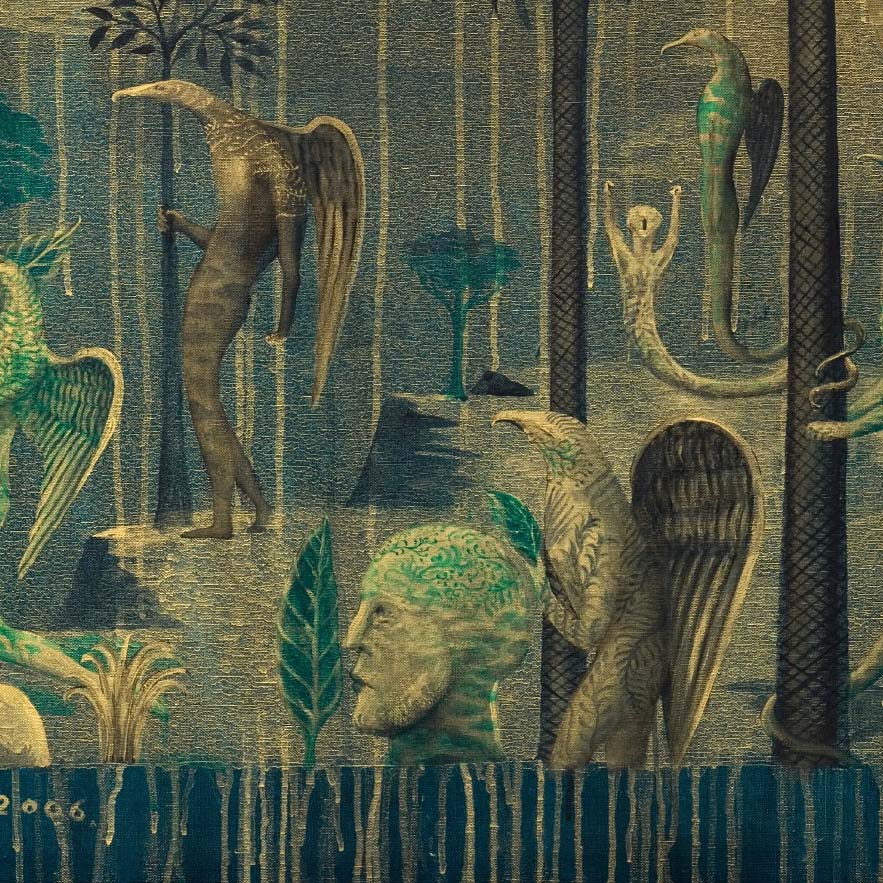The paintings of New Zealand artist Bill Hammond (1947–2021) tackle cultural history, conservation, ecology and human relations. Bill's unique vision of this country was ever evolving until his passing earlier this year.
As a young man in the late 1960s, he attended the University of Canterbury's Ilam School of Fine Arts, but it wasn’t until 1980 that he publicly exhibited his paintings. These early paintings mirror the materialistic, aggressive chaos of late 20th-century life – inanimate objects frequently mutate into living beings, giving rise to a hallucinatory reality.
During the mid-1980s, Bill recurrently used everyday support materials in his painting – metal doors, wallpaper, tent canvas and roller blinds. The images from this time reveal threatening scenarios of the onslaught of violence and are populated by comic-strip-like characters. Their atmosphere was at once humorous and scary.
In the mid-1990s, Bill's paintings represented discomfiting ecological and environmental issues. Gone was the black humour of a grungy, bogan underworld from the previous decade. Clothed, half-human, half-bird creatures populate – or stalk – these works.

This painting can be traced back to a visit to the Auckland Islands that Bill made in 1991. It was a transformative experience for him and became a defining moment for his art. He wrote about how the journey affected him: 'I saw a New Zealand before there were men, women, dogs and possums. When you see it without the people, you know that the soulful, beautiful thing about New Zealand is the land.'
Arriving at the Auckland Islands was eye-opening for Bill – the sub-Antarctic environment was almost unoccupied by humans. Birds were everywhere. He realised how, in the past, Aotearoa had hosted a unique ornithological ecosystem, which he described as 'Birdland'.
A century earlier, Aotearoa's birdlife was gaining international attention through the publication of Sir Walter Buller's illustrated book A History of New Zealand Birds (1872). However, while researching his book, Buller contributed to the extinction of indigenous bird species.
The eyes of Bill's bird figures rarely meet ours. We mirror their role as watchers, observers of a past reality where avian creatures act like our avatars. Their pastimes seem much like human recreation – they relax, drink, play pool, and interact with offspring. Their attitudes and gestures convey mutual awareness and indicate how they live in a community.
Bill's Giant Eagle is a valedictory painting. It offers homage to the long-extinct New Zealand eagle, hōkioi (Harpagornis moorei), also known as Haast's eagle, and the world's largest flying bird. While the moa (Dinornis robustus and Dinornis novaezelandiae) is arguably better known, the hōkioi was equally impressive. It was first publicised in the 1870s when Sir Julius von Haast discovered skeletal remains in a swamp. With no mammals to hunt, the raptor, which only lived in the South Island, became a dedicated bird eater.
Scientists believe that the New Zealand eagle preyed on numerous local birds, including the moa. Only three complete sets of hōkioi bones have been found, with the most recent set discovered in 1989 in a Nelson cave. The youngest group of bones is over 500 years old. Because the giant eagle was at the top of New Zealand's food chain, it never existed in great numbers. No one yet knows why the hōkioi became extinct, but it disappeared about the same time as the moa.

Bill's reimagined hōkioi is visually resurrected with an immense physical presence. Giant Eagle, 2006 presents the hōkioi in a concert performance, playing a cello sonata to an attentive audience of birds. The cello's stave is fabricated from a moa's neck showing that the eagle's natural prey has become a close ally. It kneels on a high mesa set on a plain littered with moa bones — this volcanic plateau serves as a theatrical set, a mesa covered with tarpaulin. Everything coexists in a theatrical tableau. Birds gather in the foreground overlook, surveying the eagle. The painter creates variants of Auckland Island flora, the tree daisy (Olearia lyallii)) and the southern rātā (Metrosideros umbellata). The birds appear local and familiar to us but are not recognised as identifiable species. The birds have tangible echoes of endangered or even extinct birds, such as the South Island kōkako (Callaeas cinereus).
Visual echoes of Egyptian mural art abound, figures move in silhouette, and a 'forest primitivism'' seen in the work of artists like Henri Rousseau frequent the painting. An impression of an elegiac musical event occurring to honour an extinct avian predator pervades Giant Eagle.
In Giant Eagle, the birds assemble in a dramatic underworld. They witness an open-air musical concert, a moment close to the eagle's extinction. The painting's mood is not one of grief but of an inexorable environmental fate. Pathos and gravity envelop the isolation, rendered through a painted haze of transparent golden glazes.
